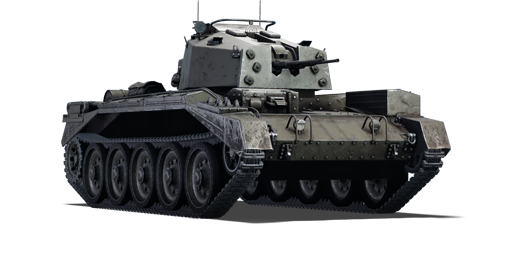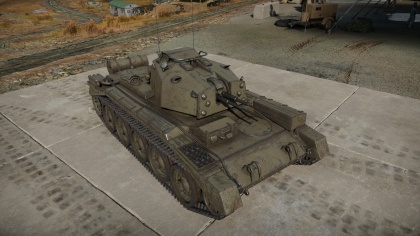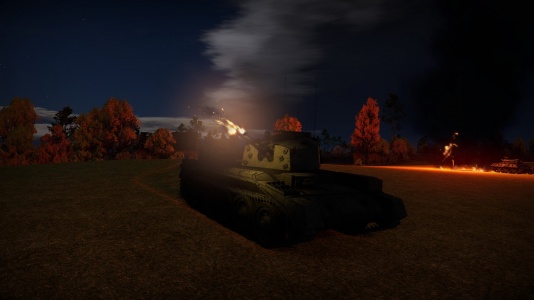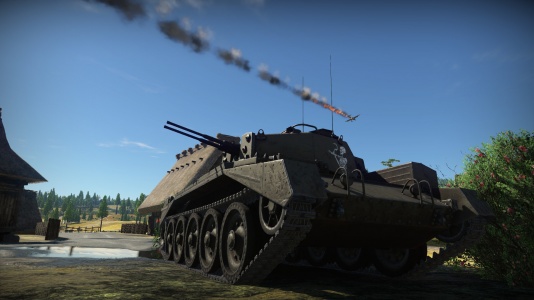Difference between revisions of "Crusader AA Mk II"
(Edits) |
(Edits) |
||
| Line 15: | Line 15: | ||
=== Survivability and armour === | === Survivability and armour === | ||
<!-- ''Describe armour protection. Note the most well protected and key weak areas. Appreciate the layout of modules as well as the number and location of crew members. Is the level of armour protection sufficient, is the placement of modules helpful for survival in combat? If necessary use a visual template to indicate the most secure and weak zones of the armour.'' --> | <!-- ''Describe armour protection. Note the most well protected and key weak areas. Appreciate the layout of modules as well as the number and location of crew members. Is the level of armour protection sufficient, is the placement of modules helpful for survival in combat? If necessary use a visual template to indicate the most secure and weak zones of the armour.'' --> | ||
| + | |||
'''Armour type:''' | '''Armour type:''' | ||
| Line 46: | Line 47: | ||
{| class="wikitable" style="text-align:center" width="100%" | {| class="wikitable" style="text-align:center" width="100%" | ||
|- | |- | ||
| − | ! colspan=" | + | ! colspan="6" | [[Oerlikon Mk.II (20 mm)|20 mm Oerlikon Mk.II]] (x2) || colspan="5" | Turret rotation speed (°/s) || colspan="4" | Reloading rate (seconds) |
|- | |- | ||
| − | ! Mode !! Capacity !! Vertical !! Horizontal !! Stabilizer | + | ! Mode !! Capacity (Belt) !! Fire rate !! Vertical !! Horizontal !! Stabilizer |
! Stock !! Upgraded !! Full !! Expert !! Aced | ! Stock !! Upgraded !! Full !! Expert !! Aced | ||
! Stock !! Full !! Expert !! Aced | ! Stock !! Full !! Expert !! Aced | ||
|- | |- | ||
! ''Arcade'' | ! ''Arcade'' | ||
| − | | rowspan="2" | | + | | rowspan="2" | 1,200 (60) || rowspan="2" | 450 || rowspan="2" | -5°/+87° || rowspan="2" | ±180° || rowspan="2" | N/A || 61.64 || 85.32 || 103.60 || 114.57 || 121.88 || rowspan="2" | 7.80 || rowspan="2" | 6.90 || rowspan="2" | 6.36 || rowspan="2" | 6.00 |
|- | |- | ||
! ''Realistic'' | ! ''Realistic'' | ||
| Line 61: | Line 62: | ||
==== Ammunition ==== | ==== Ammunition ==== | ||
| − | * '''Default:''' {{Annotation|AP-T|Armour-piercing tracer}}{{-}}{{Annotation|HEF-I|High-explosive fragmentation incendiary}}{{-}}{{Annotation|AP-T|Armour-piercing tracer}} - This | + | * '''Default:''' {{Annotation|AP-T|Armour-piercing tracer}}{{-}}{{Annotation|HEF-I|High-explosive fragmentation incendiary}}{{-}}{{Annotation|AP-T|Armour-piercing tracer}} - This belt carries an equal mixture of HEF-I and AP-T. |
* '''HET:''' {{Annotation|HEFI-T|High-explosive fragmentation incendiary tracer}}{{-}}{{Annotation|HEF-I|High-explosive fragmentation incendiary}}{{-}}{{Annotation|HEF-I|High-explosive fragmentation incendiary}} - This is the belt you want to research first, since they are the best against aircraft. | * '''HET:''' {{Annotation|HEFI-T|High-explosive fragmentation incendiary tracer}}{{-}}{{Annotation|HEF-I|High-explosive fragmentation incendiary}}{{-}}{{Annotation|HEF-I|High-explosive fragmentation incendiary}} - This is the belt you want to research first, since they are the best against aircraft. | ||
| − | * '''APT:''' {{Annotation|AP-T|Armour-piercing tracer}} - These are purely AP-T belts | + | * '''APT:''' {{Annotation|AP-T|Armour-piercing tracer}} - These are purely AP-T belts. They are not always useful with only 42 mm of penetration, but it is always a good idea to carry a round of them for self-defence; it can knockout lightly armoured vehicles. |
{| class="wikitable sortable" style="text-align:center" width="100%" | {| class="wikitable sortable" style="text-align:center" width="100%" | ||
| − | ! colspan=" | + | ! colspan="8" | Penetration statistics |
|- | |- | ||
| − | ! rowspan="2" data-sort-type="text" | | + | ! rowspan="2" data-sort-type="text" | Belt |
! colspan="6" | '''Penetration @ 0° Angle of Attack (mm)''' | ! colspan="6" | '''Penetration @ 0° Angle of Attack (mm)''' | ||
|- | |- | ||
| Line 78: | Line 79: | ||
|- | |- | ||
| APT || 42 || 40 || 30 || 21 || 15 || 11 | | APT || 42 || 40 || 30 || 21 || 15 || 11 | ||
| + | |- | ||
| + | |} | ||
| + | {| class="wikitable sortable" style="text-align:center" width="100%" | ||
| + | ! colspan="10" | Belt details | ||
| + | |- | ||
| + | ! rowspan="2" data-sort-type="text" | Belt | ||
| + | ! rowspan="2" | Type of<br>warhead | ||
| + | ! rowspan="2" | Velocity<br>(m/s) | ||
| + | ! rowspan="2" | Projectile<br>Mass (kg) | ||
| + | ! rowspan="2" | Fuse delay<br>(m) | ||
| + | ! rowspan="2" | Fuse sensitivity<br>(mm) | ||
| + | ! rowspan="2" | Explosive Mass<br>(TNT equivalent) (g) | ||
| + | ! colspan="3" | Ricochet | ||
| + | |- | ||
| + | ! 0% !! 50% !! 100% | ||
| + | |- | ||
| + | | APT || AP-T || 830 || 0.14 || N/A || N/A || N/A || 47° || 60° || 65° | ||
|- | |- | ||
|} | |} | ||
| Line 98: | Line 116: | ||
== Usage in battles == | == Usage in battles == | ||
<!-- ''Describe the tactics of playing in the vehicle, the features of using vehicles in the team and advice on tactics. Refrain from creating a "guide" - do not impose a single point of view but instead give the reader food for thought. Describe the most dangerous enemies and give recommendations on fighting them. If necessary, note the specifics of the game in different modes (AB, RB, SB).'' --> | <!-- ''Describe the tactics of playing in the vehicle, the features of using vehicles in the team and advice on tactics. Refrain from creating a "guide" - do not impose a single point of view but instead give the reader food for thought. Describe the most dangerous enemies and give recommendations on fighting them. If necessary, note the specifics of the game in different modes (AB, RB, SB).'' --> | ||
| − | Though the Crusader AA Mk.II was meant for SPAA, the twin 20 mm cannons mean this vehicle can annihilate thin-skinned vehicles with ease, such as the [[8,8 cm Flak 37 Sfl. | + | Though the Crusader AA Mk.II was meant for SPAA, the twin 20 mm cannons mean this vehicle can annihilate thin-skinned vehicles with ease, such as the [[8,8 cm Flak 37 Sfl.]] or the [[M15A1 CGMC]], as the 20 mm will slice through the thin half-track armour to knock out the crew. |
'''''Prefered fighting locations'''''<br> | '''''Prefered fighting locations'''''<br> | ||
| Line 114: | Line 132: | ||
Due to the relatively low ammo reserve, only take one type of belt with you and take as much you can carry as the ammo will run out quickly when it is split apart for both belts. | Due to the relatively low ammo reserve, only take one type of belt with you and take as much you can carry as the ammo will run out quickly when it is split apart for both belts. | ||
| − | Due to the closed nature of the vehicle, the Crusader AA Mk.II doesn't need to worry about strafing fighters as they will often not do any serious damage to the crew. However, ground attackers like the [[IL-2_(1942)| | + | Due to the closed nature of the vehicle, the Crusader AA Mk.II doesn't need to worry about strafing fighters as they will often not do any serious damage to the crew. However, ground attackers like the [[IL-2_(1942)|IL-2]] or [[P-47D-25|Thunderbolt]] are still just as deadly. Though more protected from machine gun fire, its armour is not enough to stand against enemy tanks, which would slice through the armour with shots from their cannons. |
=== Modules === | === Modules === | ||
| Line 163: | Line 181: | ||
'''Pros:''' | '''Pros:''' | ||
| − | * Using [[ | + | * Using [[Crusader Mk II]]'s chassis - fast with a low profile. |
* High fire rate and a quick reload. | * High fire rate and a quick reload. | ||
* Closed-top AAA - the crew is well protected from strafing planes. | * Closed-top AAA - the crew is well protected from strafing planes. | ||
| Line 175: | Line 193: | ||
* Essentially the armour of a Rank 1 tank. | * Essentially the armour of a Rank 1 tank. | ||
* Can only penetrate medium tanks like the Panzer IVs from the side at close range, any more armour will leave the SPAA armament useless. | * Can only penetrate medium tanks like the Panzer IVs from the side at close range, any more armour will leave the SPAA armament useless. | ||
| − | * Contemporary to the [[ | + | * Contemporary to the German [[Wirbelwind]], but with less firepower, less anti-tank ability, and less hull armour. |
* No improvement in firepower compared to the 20 mm Oerlikon cannons on the Armoured Car Mk.II AA. | * No improvement in firepower compared to the 20 mm Oerlikon cannons on the Armoured Car Mk.II AA. | ||
| Line 206: | Line 224: | ||
;Images | ;Images | ||
| − | <gallery mode="packed" | + | <gallery mode="packed" heights="200px"> |
File:Crusader AA Mk II night fury.jpg|A night shot of the '''{{PAGENAME}}''' firing its cannons. | File:Crusader AA Mk II night fury.jpg|A night shot of the '''{{PAGENAME}}''' firing its cannons. | ||
File:Crusader AA Mk II after shooting down a Ju-87.jpg|A Crusader shortly after shooting down a [[Ju 87 (Family)|Ju 87]]. | File:Crusader AA Mk II after shooting down a Ju-87.jpg|A Crusader shortly after shooting down a [[Ju 87 (Family)|Ju 87]]. | ||
| Line 215: | Line 233: | ||
* ''reference to the series of the vehicles;'' | * ''reference to the series of the vehicles;'' | ||
* ''links to approximate analogues of other nations and research trees.'' --> | * ''links to approximate analogues of other nations and research trees.'' --> | ||
| + | |||
* [[wt:en/devblog/current/855/|[Devblog] Crusader AA Mk.I and Crusader AA Mk.II]] | * [[wt:en/devblog/current/855/|[Devblog] Crusader AA Mk.I and Crusader AA Mk.II]] | ||
Revision as of 11:59, 13 October 2020
Contents
| This page is about the British SPAAG Crusader AA Mk II. For other versions, see Crusader (Family). |
Description
The Tank, Cruiser, Crusader III, AA Mk II is a rank III British self-propelled anti-aircraft gun
with a battle rating of 5.0 (AB) and 4.0 (RB/SB). It was introduced along with the entire British tree line in Update 1.55 "Royal Armour".
General info
Survivability and armour
Armour type:
- Rolled homogeneous armour
- Cast homogeneous armour (Gun mantlet, Driver's port)
| Armour | Front | Sides | Rear | Roof |
|---|---|---|---|---|
| Hull | 20 mm (33°) Front plate 9 mm (86°), 20 mm (62°) Front glacis 20 mm (26-64°) Lower glacis 18 mm (1°) Driver's plate |
14 mm | 14 mm (44-50°) Top 14 mm (14°) Bottom |
7 mm |
| Turret | 30 mm (5°) 30 mm (2-52°) |
14 mm (7-9°) | 17 mm (6-39°) | 12.7 mm |
Notes:
- Suspension wheels and tracks are 15 mm thick.
- The driver's port at the driver's position offers up to 50 mm of protection in cast homogeneous armour.
Mobility
| Game Mode | Max Speed (km/h) | Weight (tons) | Engine power (horsepower) | Power-to-weight ratio (hp/ton) | |||
|---|---|---|---|---|---|---|---|
| Forward | Reverse | Stock | Upgraded | Stock | Upgraded | ||
| Arcade | 48 | 8 | 19.6 | 483 | 649 | 24.64 | 33.11 |
| Realistic | 44 | 7 | 301 | 340 | 15.36 | 17.35 | |
Armaments
Main armament
| 20 mm Oerlikon Mk.II (x2) | Turret rotation speed (°/s) | Reloading rate (seconds) | ||||||||||||
|---|---|---|---|---|---|---|---|---|---|---|---|---|---|---|
| Mode | Capacity (Belt) | Fire rate | Vertical | Horizontal | Stabilizer | Stock | Upgraded | Full | Expert | Aced | Stock | Full | Expert | Aced |
| Arcade | 1,200 (60) | 450 | -5°/+87° | ±180° | N/A | 61.64 | 85.32 | 103.60 | 114.57 | 121.88 | 7.80 | 6.90 | 6.36 | 6.00 |
| Realistic | 41.65 | 49.00 | 59.50 | 65.80 | 70.00 | |||||||||
Ammunition
- Default: AP-T · HEF-I · AP-T - This belt carries an equal mixture of HEF-I and AP-T.
- HET: HEFI-T · HEF-I · HEF-I - This is the belt you want to research first, since they are the best against aircraft.
- APT: AP-T - These are purely AP-T belts. They are not always useful with only 42 mm of penetration, but it is always a good idea to carry a round of them for self-defence; it can knockout lightly armoured vehicles.
| Penetration statistics | |||||||
|---|---|---|---|---|---|---|---|
| Belt | Penetration @ 0° Angle of Attack (mm) | ||||||
| 10 m | 100 m | 500 m | 1,000 m | 1,500 m | 2,000 m | ||
| Default | 42 | 40 | 30 | 21 | 15 | 11 | |
| HET | 2 | 2 | 2 | 2 | 2 | 2 | |
| APT | 42 | 40 | 30 | 21 | 15 | 11 | |
| Belt details | |||||||||
|---|---|---|---|---|---|---|---|---|---|
| Belt | Type of warhead |
Velocity (m/s) |
Projectile Mass (kg) |
Fuse delay (m) |
Fuse sensitivity (mm) |
Explosive Mass (TNT equivalent) (g) |
Ricochet | ||
| 0% | 50% | 100% | |||||||
| APT | AP-T | 830 | 0.14 | N/A | N/A | N/A | 47° | 60° | 65° |
Ammo racks
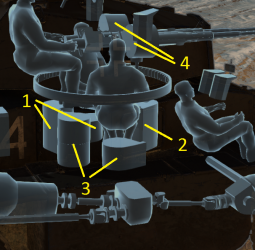
| Full ammo |
1st rack empty |
2nd rack empty |
3rd rack empty |
4th rack empty |
Visual discrepancy |
|---|---|---|---|---|---|
| 10 | 8 (+2) | 6 (+4) | 4 (+6) | 2 (+8) | Yes |
Usage in battles
Though the Crusader AA Mk.II was meant for SPAA, the twin 20 mm cannons mean this vehicle can annihilate thin-skinned vehicles with ease, such as the 8,8 cm Flak 37 Sfl. or the M15A1 CGMC, as the 20 mm will slice through the thin half-track armour to knock out the crew.
Prefered fighting locations
Due to the heavy ammunition consumption as SPAA in AA fights, stay at "safe" capture points to get free ammunition to reload during battle. If forced to return to a cap point early in the game, this will often be a death sentence.
Ammunition
This vehicle has multiple uses depending on which type of ammunition is selected.
HET is recommended for destroying planes, but it would be impossible to destroy a tank with them. If such an encounter occurs, get out of the vicinity and do not draw the attention of tanks like the T-34-57 or Tiger will one shot this SPAA. When shooting planes try to aim for bombers and ground attack planes as they won't be able to outmanoeuvre the shots.
APT rounds gives a lot more choices. Though it is a Rank 3 vehicle, the low battle rating means it will be matched against Rank 2 opponents, many of which won't stand a chance if shot from the sides with APT. If in a higher rank battle (with opponents like the Panther D and the IS-1), this tactic will often not work. However, the Mark II can still tear apart tracks and gun barrels just as easily with the APT rounds.
As for the default belt, it is probably better off changing to prioritize HET or APT.
Due to the relatively low ammo reserve, only take one type of belt with you and take as much you can carry as the ammo will run out quickly when it is split apart for both belts.
Due to the closed nature of the vehicle, the Crusader AA Mk.II doesn't need to worry about strafing fighters as they will often not do any serious damage to the crew. However, ground attackers like the IL-2 or Thunderbolt are still just as deadly. Though more protected from machine gun fire, its armour is not enough to stand against enemy tanks, which would slice through the armour with shots from their cannons.
Modules
| Tier | Mobility | Protection | Firepower | ||
|---|---|---|---|---|---|
| I | Tracks | Parts | HET | Horizontal Drive | |
| II | Suspension | Brake System | FPE | APT | Adjustment of Fire |
| III | Filters | Crew Replenishment | Elevation Mechanism | ||
| IV | Transmission | Engine | Artillery Support | ||
- Like every other vehicle, the "Parts" and "FPE" modifications should be prioritized so you won't lose your vehicle due to being disabled.
- After that, prioritize on the different ammunition, aiming for "HET", for better anti-air performance.
- Getting "Horizontal Drive" next is recommended for aiming at high-speed targets
- Everything else is extra, but still essentials to upgrading the vehicle.
Pros and cons
Pros:
- Using Crusader Mk II's chassis - fast with a low profile.
- High fire rate and a quick reload.
- Closed-top AAA - the crew is well protected from strafing planes.
- Extremely dangerous for vehicles with the armour of 40 mm or less.
- Rank III vehicle - suitable for completing missions for war bonds and events.
- Lightly armoured vehicles like armoured cars, SPAA, and tank side armour can be an easy target to the rapid-fire 20 mm autocannons.
Cons:
- Limited ammo supply (can be a problem when losing on one point maps).
- Essentially the armour of a Rank 1 tank.
- Can only penetrate medium tanks like the Panzer IVs from the side at close range, any more armour will leave the SPAA armament useless.
- Contemporary to the German Wirbelwind, but with less firepower, less anti-tank ability, and less hull armour.
- No improvement in firepower compared to the 20 mm Oerlikon cannons on the Armoured Car Mk.II AA.
History
Development
In 1938, the General Staff of the British Army requested a cruiser tank that was lighter and more affordable than the heavier A16 cruiser design developed by Nuffield Mechanizations & Aero. One of these designs was the designation Tank, Cruiser Mk.V based off the A13 cruiser tanks, named the "Covenanter", and Nuffield was invited to become part of its development team, but they refused due to interest in developing their own cruiser tank. Their tank was designated the Tank, Cruiser Mk.VI Crusader and fell under the General Staff specification of A15. The Crusader was a parallel design to the Covenanter but was ready six weeks earlier than the Covenanter despite starting at a later time. The Crusader was adopted into service with the British Army in 1941 and the 5,300 units were manufactured between 1940 to 1943.
Design
The Crusader features a new design that differs from its cruiser tank predecessors. The Christie suspension system on the Crusader had five road wheels for it instead of the usual four, which improves weight distribution of the increased 20-ton weight of the Crusader compared to the 14 tons of the A13 cruisers. The engine, steering system, and cooling system on the Crusader was different as well, but the Covenanter and Crusader use the same main turret. The polygonal shape of the turret gives the crew inside more room for the turret ring diameter.
The Crusader Mk.I and Mk.II were equipped with the 2-pounder, which was aimed by the gunner inside with a padded shaft that allows them to elevate the gun by simply adjusting his own height. Later in the war where an up-gun of the tank armament was necessary and newer tanks such as the Cromwell was delayed, the Crusader was upgraded into the Crusader Mk III variant with a 6-pounder instead, which restricted turret space, requiring the turret crew to be reduced from three to two. These saw the first action the Second Battle of El Alamein in October 1942.
Combat usage
The Crusader first saw action at North Africa, right after the British had been pushed back to the Egyptian border by Axis forces. The Crusaders were part of the huge shipment in the Malta Convoys to reequip the British forces there. Enough Crusaders arrive that the entire 6th Royal Tank Regiment was refitted with them, which joined up with the 2nd Royal Tank Regiment to form the 7th Armoured Brigade "Desert Rats". The brigade's first action was in Operation Battleaxe, though it was delayed due to adapting the tanks for the desert environment. The operation, which called for the relieve of the siege of Tobruk in June, was initiated in June to which 11 Crusader tanks were lost to anti-tank guns, plus many more to mechanical faults. While more Crusader tanks came in to reinforce the cruiser tank forces, there were never enough to supply the continuously expanding armoured units as 7th Brigade was combined with the 7th Hussars, the 2nd Armoured Brigade was added to the 7th Armoured Division, and the 8th Hussars was combined with the 4th Armoured Brigade. Overall, the Crusaders proved effective in the North African Campaign, the Crusader was faster than any tanks on the opposing side and the 2-pounder was lethal to the Panzer III, but the tank suffered from its thin armour, mechanical problems in the desert, and the growing deficiency of the 2-pounder, which didn't have enough range to destroy farther tanks. The Crusader design also caused the ammo racks on the tank to easily ignite due to unprotected racks and shot traps on the turret design. Anti-tank guns continue to be the main reason the Crusader units suffer losses, rather than to enemy tanks.
By the end of 1941, only the 2nd Armoured Brigade retained the Crusaders, the rest of the other tank units were being refitted with better tanks, such as the M3 Grant medium tank from the American Lend-Lease. Crusader units were also refitted with the more powerful Crusader Mk.III with the 6-pounder, which improved the Crusader's ability to destroy the gradually stronger German tanks. After General Bernard Montgomery took command of the British Army in 1942, more British tank units were re-equipped with the Grant and M4 Sherman tanks while the Crusaders were relegated from the front-lines to "light squadrons" meant to flank the enemy and attacked at its exposed sides. When the British 1st Army engaged the Axis at Tunisia, some tank regiments still use Crusaders mixed in with Valentine tanks. These units in the 26th Armoured Brigade, code-named "Blade Force", worked alongside the 78th Infantry Division as an independent armoured column. During Tunisia, the 1st Army was already converting the tank regiments into Shermans, but the 8th Army continued to use the Crusaders for much longer, which would see use at the Battle of Wadi Akarit and Mareth Line.
After the North African Campaign, the Crusaders no longer saw any use in the front-lines and were used in other roles such as gun tractors with 17-pounders or anti-aircraft mounts such as the Crusader AA Mk.I and Mk.II Some Crusader tanks equipped the tank regiments that stayed back at the British Homelands such as the 11th Armoured Division.
The AA tank Mark II replaced the obsolete Mark VI AA tanks that had been in the four-vehicle anti-aircraft troop in a British armoured regiment or infantry tank battalion, starting with the Normandy landings. The lack of German air targets meant they were largely used against ground targets. These regimental AA troops in France in 1944 used a mix of Crusader Mark IIs, Crusader AA Mk IIIs (which had a coaxial machine gun as well), and similarly armed Centaur AA tanks (based on an early version of the Cromwell that was also no longer useful as a battle tank).
Survivors
About 21 Crusaders still exist intact in various parts of the world. The most notable places with the Crusaders are South Africa with 8 known survivors, a running Crusader Mk III at Bovington Tank Museum at England, and an anti-aircraft version at Musée des Blindés in France.
Media
- Skins
Skins and camouflages for the Crusader AA Mk.II from live.warthunder.com.
- Images
A Crusader shortly after shooting down a Ju 87.
See also
External links
Paste links to sources and external resources, such as:
- topic on the official game forum;
- encyclopedia page on the tank;
- other literature.
| Britain anti-aircraft vehicles | |
|---|---|
| Crusader AA | Crusader AA Mk I · Crusader AA Mk II |
| Wheeled | Staghound AA · AEC AA |
| Radar SPAAG | Chieftain Marksman |
| Missile SPAA | Stormer AD · Stormer HVM |
| Other | Light AA Mk I · Falcon |
| Canada | Skink · ADATS (M113) |
| South Africa | Ystervark · Bosvark · ZA-35 |


